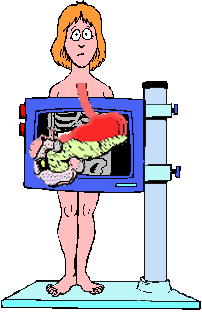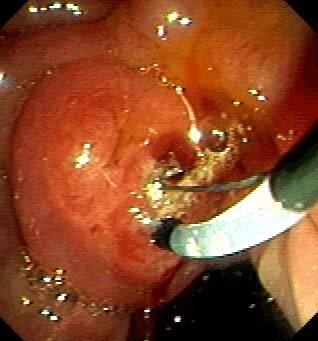



Last updated: August 22, 2003
Clinical information system with image documentation GastroBase-II
Information system of the Faculty Hospital Prague (Medical Clinics) with Laboratory Information Module and Module GastroBase-II including Image Processing - PACS.
 Unusual, atypical, misdiagnosed cases - Image Atlas
Unusual, atypical, misdiagnosed cases - Image Atlas
 Database of endoscopic/X-Ray/UltraSound images !!! NEW !!!
Database of endoscopic/X-Ray/UltraSound images !!! NEW !!!
 Abstract
Abstract
GastroBase - as a clinical information system - incorporates patient identification, medical records, images, laboratory data, patient history, physical examination and other patient related information. Program modules are written in C-language, all data are processed by using Novell-Btrieve data manager. Patient-identification database represents the main core of this information systems. Graphic library developed in the past year and graphic modules with a special video-card enables to store, archive and link different images to the electronic patient-medical-record. GastroBase is routinely used now more than five years and the database contains > 100.000 medical records and 3000 images. The CD-ROM electronical textbook was prepared for pre- and post-graduate education.
Introduction
The importance of computing medical documentation is not doubted. All data stored in the computer memory are easy to access, share and search, replace the written documentation, and decrease the non-medical (administrative work) of medical staff. The GastroBase program is suitable for documentation of gastroduodenoscopy, ERCP, colonoscopy, proctosigmoidoscopy, including all therapeutic techniques, ultrasonography, laparoscopy as well as to describe histology, X-ray and surgical reports in connections with hematology and clinical chemistry laboratories. The GastroBase has been developed in 1990 as a Fox Base+ LAN application and the last version written in C-language including a graphic library was incorporated into a clinical-information system, which is under developing at the University Clinic in Prague.
GastroBase Description
Electronic-patient-record (EPR) system GastroBase-I has been developed in 1990 as a full structured text editor; suitable for documentation of gastroenterological endoscopy. The GastroBase-II system running on Btrieve data manager (Novell NetWare 3.12, - 4.11) is routinely used at our department since June 1995. GastroBase-II as a clinical information system - incorporates patient identification, medical records, images, laboratory data, patient history, physical examination and other patient related information. Patient-identification database represents the main core of this information system. Graphic library developed in the past years and graphic modules with a special video-card enables to store, archive and link different images to the electronic patient-medical-record.
Medical-records in GastroBase are written and stored by using of the standardized texts/codes (minimal data set) covering the whole range of the gastroenterology, developed at our department in 1990-1992 years. These codes are constructed in general rules as abbreviation (codes for tumors start with "t" etc.) and are composed by a combination of the proper code, numeric parameters (size, distance) and anatomical localizations. This minimal-data set is closely related to the International-Endoscopy OMED-terminology. Examination reports are typed quicker, in a standardized form and can be easily searched and evaluated by simple expert-system modules, incorporated into GastroBase-II. The expert-system modules are used as example for automatic generation of the health-insurance payment, request of histopathology examination of tissue samples yielded by endoscopic procedure.
Separate routines involve screening, prevention and follow-up for colorectal cancer and a national registry of the familiar polyposis of the large bowel.
GastroBase EPR can be shared with other departments, connected by network, all EPR could be exported in text, structured data or database form. The system enables communication with other department, clinical and haematology laboratories and can import and convert results of these departments.
Image processing and archivation (PACS)
 Images - real time screen pictures - from videoendoscopy, ultrasound, endosono-graphy and X-ray contrast pictures (ERCP) could be stored and retrieved as a part of patient's documentation. These images are captured by video-cards connected to PC in the PC-network, processed in true-color Targa (TGA) format and archived after compression to the standard GIF (Graphic Interface Format). Microimages - 'thumbprint' for each image 120 x 120 pixels are stored in the graphic library. These microimages could be easy retrieved and linked to medical record and serves as a summary of the whole medical procedure. Different microimages (endoscopic, X-ray, ultrasound) could be previewed on the true-color display. A graphic library module has been developed as a tool to capture, process and manage images and responding microimages. The specific hardware and software has been developed by Czech company ComSyD (from 1997 company name is Codep sro, www.codep.cz).
Images - real time screen pictures - from videoendoscopy, ultrasound, endosono-graphy and X-ray contrast pictures (ERCP) could be stored and retrieved as a part of patient's documentation. These images are captured by video-cards connected to PC in the PC-network, processed in true-color Targa (TGA) format and archived after compression to the standard GIF (Graphic Interface Format). Microimages - 'thumbprint' for each image 120 x 120 pixels are stored in the graphic library. These microimages could be easy retrieved and linked to medical record and serves as a summary of the whole medical procedure. Different microimages (endoscopic, X-ray, ultrasound) could be previewed on the true-color display. A graphic library module has been developed as a tool to capture, process and manage images and responding microimages. The specific hardware and software has been developed by Czech company ComSyD (from 1997 company name is Codep sro, www.codep.cz).
The data security is covered by daily backup of all data to another file server in LAN, long - term archivation is now made on optical WORM media (Olympus 640 MB optical disc) and by re-writing to a CD-ROM media twice per year.
 Educational aspects
Educational aspects
The graphic-library modules of GastroBase-II system could be easily used for educational purposes. Searching by keyword enables us to demonstrate specific procedure, individual stages of this procedure, relation to different examination techniques (i.e. combination of endoscopy with X-ray or with ultrasound) or a specific diagnosis or pathological result. We have now more than 2000 images accessible on network disc, and long-term storage archive on optical disc (CD-ROM. These image-data are used for pre graduate as well as post-graduate educational activities. Our teaching and seminar room is now equipped with modern computer presentation unit (including LCD panel with Cyclope, Ovation 820 system). Clinical data are presented by using a GastroBase-II software or these images are incorporated into presentations prepared in Microsoft PowerPoint. The educational - postgraduate multimedia - a CD-ROM electronical textbook - was developed and published in 1997 by Praha Publishing (Czech Republic). This CD-ROM software has been programmed by using VisualBasic as a hyper-text oriented electronic book with full-text searching, images and video-sequences covering endoscopy, X-ray and endo-ultrasound examinations.
Internet - WWW presentation: Selected cases (atypical, unusual cases) from GastroBase IS were converted to HTML structure incl. image documentation and are presented via Internet on our pages Atypical, unusual cases . Documentation presented on these pages has been digitalized on-line by using the GastroBase-II module (Information System of the Medical Clinics of Fac.Hospital, Prague). All data are presented anonymously with agreement of the directory of our Hospital and are intendt for postgraduate education of gastroenterologists. Some of our cases are also selected to be included in the Virtual Electronic Library of Unusual Clinical Cases - in the ELCANO project at URL: www.imim.es/elcano/.
Some URL links concerning the Telemedicine, Images and Standards: Minimal Standard Terminology - MST www.uni.net/omed/minimal.htm, projekt Gaster www.gaster.org, information on DICOM standard http://medical.nema.org/dicom/2001.html - full texts in PDF files, download of DICOM software - demo www.desacc.com/index.html.
References:
Kocna, P.; Kocna, J.; Frič, P.: Computer data processing in clinical gastroenterology. Abs.Comp.in Medicine and Health Care; Karlovy Vary; 1990; 256
Kocna, P.; Kocna, J.; Frič, P.: Computer aided documentation in clinical gastroenterology GastroBase. Proceedings MEDINFO'92 Geneva September 6 10; 1992; 1: 158
Kocna, P.; Kocna, J.; Neuwirt, K.; Frič, P.: Computer aided documentation in Clinical Gastroenterology GastroBase. Health Systems The Challenge of Change; 1992; 353 1356
Kocna, P.; Kocna, J.; Frič, P.: Endoscopic results and images using Gastrobase Computer data processing in clinical gastroenterology. Endoscopy; 1993; 25: 5, 353
Kocna, P.: The clinical information system GastroBase: Integration of image processing and laboratory communication. MEDINFO'95 Proceedings ed.R.A.Greenes; 1995; 1: 441
Kocna, P.: Electronic Medical Record Images Integration and Educational Aspects. Abstract of EuroMISE 95 Conference, Prague October 1995; 38
Kocna, P.: Electronic medical record in GastroBase-II. Clinical and educational aspects. Studies in Health Technology and Informatics; 1996; 34: 1, 440-442
Kocna P.,Frič P.,Zavoral M.: Endoscopic Methods - ERCP and colonoscopy, CD-ROM electronic textbook, Praha Publ. 1997
Kocna, P.: Multimedia Electronic Textbook. The way from clinical information to education. Proceedings TEPR'97, Nashville, May 1997 ; 3: 362-364
Kocna, P.: Endoscopic image documentation - Clinical and educational experiences, Digestion, 1998, 59, Suppl.3, 544

Icons for Webmasters :







